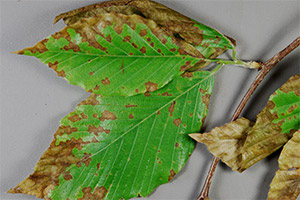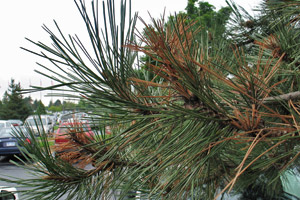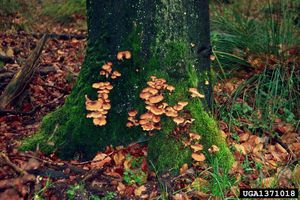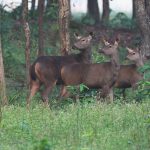Four Common Tree Diseases
If your trees become diseased, it can cause damage, decay, and even death. If you think that your trees are infected with a possible disease, it is important to determine what the specific disease is so you can find the right solution. There are a variety of different diseases that can cause significant destruction to the shrubs and trees in your yard, and fortunately, there are several methods to fix the problem.
Fungicides are regularly used to control tree diseases. These can be sprayed or injected into the tree trunk, or even added directly into the root soil. In some cases, regularly pruning and fertilizing the tree can help reduce symptoms of disease.
If you’re considering trying to treat a diseased tree, be sure to contact our team at Inexpensive Tree Care first. We will take a close look at the tree and give you advice on what treatments will work best to control the disease and offer tips on how to properly apply them. Not sure what disease is infecting your trees? Here are four well-known tree diseases and what symptoms to look for.
Anthracnose
 Anthracnose infections is commonly seen in the Eastern United States and affects many shade and ornamental trees. These include ash, basswood, birch, catalpa, dogwood, hickory, horsechestnut, tuliptree and black walnut. The infection can be particularly severe on American sycamore trees, as well as other trees in the white oak group. Anthracnose is a host-specific disease, which means that the species of fungi attacking the ash tree will not affect birch or sycamore trees that are nearby. There are numerous recognized species of the fungi.
Anthracnose infections is commonly seen in the Eastern United States and affects many shade and ornamental trees. These include ash, basswood, birch, catalpa, dogwood, hickory, horsechestnut, tuliptree and black walnut. The infection can be particularly severe on American sycamore trees, as well as other trees in the white oak group. Anthracnose is a host-specific disease, which means that the species of fungi attacking the ash tree will not affect birch or sycamore trees that are nearby. There are numerous recognized species of the fungi.
The most recognizable sign of anthracnose is dead spots or blotches on the leaves. These discolorations can be black, brown, or purple and are often seen on the veins of the leaves. Infected leaves oftentimes become oddly shaped because of the irregular growth that’s happening between the healthy and diseased parts of the leaf.
Dothistroma Needle Blight of Pines
 Dothistroma needle blight is a fungal infection that causes premature defoliation in mature trees and severe stunting and death in young trees. It has been identified in over 35 pine species across North America and in the Pacific Northwest and California, it has been seen in lodgepole and Monterey pines.
Dothistroma needle blight is a fungal infection that causes premature defoliation in mature trees and severe stunting and death in young trees. It has been identified in over 35 pine species across North America and in the Pacific Northwest and California, it has been seen in lodgepole and Monterey pines.
Dothistroma can be recognized when darker-green bands or yellow and tan spots on needles develop. The dark green bands are short-lived and can easily be missed, as the will start turning brown or reddish brown if the infection continues. On the West Coast and in Idaho, dothistroma is commonly referred to as the “red band disease” because the bands on the needles are redder and more numerous than they are in other regions. A dothistroma needle blight infection is typically most severe in the lower crown of the tree.
Armillaria Root Rot
 Armillaria root rot is seen in all states and will kill shrubs, vines, and forbs. Unfortunately, this disease will affect hundreds of plants to a certain degree and the only trees that are resistant to it are larch trees and birch trees. It is also the most common fungi found in forest soil. The fungi can infect healthy trees, which will either kill them or weaken them to the point of becoming infested by pests or other fungi.
Armillaria root rot is seen in all states and will kill shrubs, vines, and forbs. Unfortunately, this disease will affect hundreds of plants to a certain degree and the only trees that are resistant to it are larch trees and birch trees. It is also the most common fungi found in forest soil. The fungi can infect healthy trees, which will either kill them or weaken them to the point of becoming infested by pests or other fungi.
This type of fungus lives as a parasite on large roots and stem pieces of conifers and broad-leaved trees. It can wreak havoc on the trees for years causing decay, death, or growth reduction. For vineyard or orchard owners, this fungus can cause significant loss – especially those recently planted in forest lands or plantations.
All infected hosts show symptoms common to armillaria. One of the most common signs of infection include clusters of mushrooms that grow at the bottom of the infected tree. Other indications include lighter, bleached wood, yellowed foliage, and dieback of twigs and branches. The trunks of coniferous trees will excrete excess resin, which will result in a layer of resin, debris, and fungal tissue that cover the diseased roots. Sunken cankers on the trunk can also form on deciduous trees and to determine how deep the infection is, you can remove the bark to expose the branching and vegetative parts of the fungus.
Aspen Canker
 Quaking aspen trees are one of the most commonly seen trees in the Western United States. Aspen Canker is considered a sooty-bark canker, which is the most lethal aspen canker in the West. It is also known to affect some of the oldest and largest trees, which makes it an even more serious threat. Unfortunately, it is often identified in mature trees of 120 years or more but can destroy aspen trees of all ages.
Quaking aspen trees are one of the most commonly seen trees in the Western United States. Aspen Canker is considered a sooty-bark canker, which is the most lethal aspen canker in the West. It is also known to affect some of the oldest and largest trees, which makes it an even more serious threat. Unfortunately, it is often identified in mature trees of 120 years or more but can destroy aspen trees of all ages.
If a tree has any wound on it, the fungus will get in through those and begin invading the inner bark. Once it does this, it will grow quickly and can extend as much as three feet in length and one foot in width annually. The cankers will originally appear on the bark as a sunken oval-shaped area and it will destroy portions of the bark every year. After two or three years, the dead bark will begin falling off to expose blackened inner bark.
For more information about any of these diseases, or if you’re unsure about the overall health of your trees, contact us today. We pride ourselves on offering great customer service through honesty, value, and reliability. We look forward to hearing from you!




